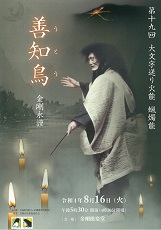Candlelit Noh: Why the Blue? Aug 16th Daimonji Noh Utoh
Utoh is one of my favorite noh plays. An unusually vivid depiction by a Bird-Hunter Ghost of his double torment: inability to return or communicate with his wife and son, attacked merciless in the everlasting hell-fires of sinners. I had produced a version for Matsui Akira's Women in Circle one-man show that he toured to Europe and the U.S., using slides of Shiko Munakata's woodblock prints with translation of "Blood-birds", an early Wetherby work. Matui danced the climactic kuse powerfully, the iron claws of the giant Auk (seabird) and bloody, fatal tears of the mother shown with vigor and pathos. A laquered black sedge hat and pole his only properties, a feather-skirt and light white vest his ghostly garments.
https://www.youtube.com/watch?v=FH8lm40bilw&t=56s
(with Richard Emmert's chorus on tour in UK)
So, I was eager to see how the head of the Kongo school would perform the piece by candlelight in the annual Daimonji noh held on the day all five surrounding mountains of Kyoto are lit up by bonfires, carving into the norther demon-gate mountains the ancient magical incantatory letters (despite the torrential rains, it happened again this year at full scale for the first time since 2019). Candlelit performances of noh take place regularly, especially in obon season of summer return of ancestral spirits. But the torchlit noh tradition and candlelit performances go back to the non-special, pre-gaslit performances in indoor theatres or outdoor shrines that existed for centuries. When done well, one can easily imagine the spirits appearing through the flickering flames, their illumination obscuring chorus and stage assistant beneath the eaves of the roofs, but shine on the lustrous masks in weird and wrenching ways.In fact, summer bonfires and fireworks, candle-ceremonies at weddings and incense attest to some fascination of the Japanese towards fire, burning, and light.
Regretfully, the show was a great disappointment. I will refrain from commenting on the performance itself--a last-minute purchase, I had a distant waki-za side view. But the 10 spaced cone-enclosed candles that should have created that mysterious dark beauty of Yugen were completely overwhelmed by the bright, blue-tinged stage lighting that was used to light up the otherwise dark wood stage. Unlike the strips of fluorescent lighting that were often found in noh theatres to provide a blanket brightness simulating daytime, the recently rebuilt Kongo and other new noh theatres have high-tech spotlights hidden surreptitiously behind roofbeams and pillars. I have seen performances at the Oe theatre where lighting in warmer colors or even between acts helps express the story subtly. So why then would actors, so attuned to the delicate shades of mask-tilts and kimono ties, permit this blue-wash that bleached out the detail of costumes, flattened the masks, and showed everyone onstage in sharp focus? The candles were less than useless, further obscuring eyelines with their annoying flickering yet providing no illumination.
Would the performance had matched the leaflet photograph! Another bucket-list of candlelit productions I would like to see/produce/direct in future, truly candelit noh Only.



Comments